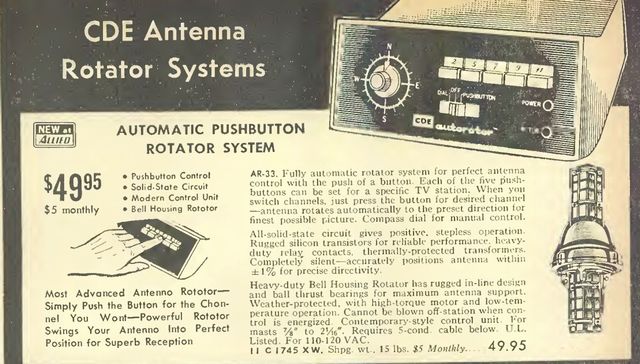Thursday, September 28, 2017
Why didn't this happen?
The classic VHF TV dial was the exact equivalent of a deck of cards.
Channel 1 was removed from the TV allocations after set design and construction had begun, so the FCC never renumbered the channels. Most sets from the late '50s through the end of analog TV had 13 positions on the dial, with the missing 1 spot selecting the UHF band. And the UHF band typically contained non-network stations, low-budget independents and religious broadcasters.
In other words, "1" was the wild card lit and fig.
So: Why didn't anyone make a TV set with the cards in place of numbers?
 Assign the suits to the directions. Arbitrarily N = clubs, E = diamonds, W = spades, S = hearts.
Then you could remember the dial and rotator for each station as a card. Example: Growing up in Manhattan, our main TV station was WIBW 13 in Topeka, which would be the King of Diamonds.
Looking at the deluxe rotator pictured above leads to a more practical whydidn't. This control mechanism could be inside the set, triggered by an extra contact on the channel switch instead of the pushbuttons on this box. You'd have to manually 'memorize' the setting initially, then the antenna would turn automatically thereafter. Seems like the sort of gadget that Zenith would have tried.
Assign the suits to the directions. Arbitrarily N = clubs, E = diamonds, W = spades, S = hearts.
Then you could remember the dial and rotator for each station as a card. Example: Growing up in Manhattan, our main TV station was WIBW 13 in Topeka, which would be the King of Diamonds.
Looking at the deluxe rotator pictured above leads to a more practical whydidn't. This control mechanism could be inside the set, triggered by an extra contact on the channel switch instead of the pushbuttons on this box. You'd have to manually 'memorize' the setting initially, then the antenna would turn automatically thereafter. Seems like the sort of gadget that Zenith would have tried.
U 2 3 4 5 6 7 8 9 10 11 12 13 A 2 3 4 5 6 7 8 9 10 J Q KIn the early '50s there were quite a few local and independent TV builders who bought chassis from the big corporations and added custom knobs and cabinets. Did any of those 'assemblers' think of this? The metaphor could be completed when you had an antenna with a rotator.
 Assign the suits to the directions. Arbitrarily N = clubs, E = diamonds, W = spades, S = hearts.
Then you could remember the dial and rotator for each station as a card. Example: Growing up in Manhattan, our main TV station was WIBW 13 in Topeka, which would be the King of Diamonds.
Looking at the deluxe rotator pictured above leads to a more practical whydidn't. This control mechanism could be inside the set, triggered by an extra contact on the channel switch instead of the pushbuttons on this box. You'd have to manually 'memorize' the setting initially, then the antenna would turn automatically thereafter. Seems like the sort of gadget that Zenith would have tried.
Assign the suits to the directions. Arbitrarily N = clubs, E = diamonds, W = spades, S = hearts.
Then you could remember the dial and rotator for each station as a card. Example: Growing up in Manhattan, our main TV station was WIBW 13 in Topeka, which would be the King of Diamonds.
Looking at the deluxe rotator pictured above leads to a more practical whydidn't. This control mechanism could be inside the set, triggered by an extra contact on the channel switch instead of the pushbuttons on this box. You'd have to manually 'memorize' the setting initially, then the antenna would turn automatically thereafter. Seems like the sort of gadget that Zenith would have tried.
